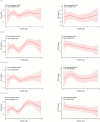Association of high-sensitivity CRP and FEV1%pred: a study on non-pulmonary disease in a population in Beijing, China
- PMID: 38479820
- PMCID: PMC10941139
- DOI: 10.1136/bmjresp-2023-001699
Association of high-sensitivity CRP and FEV1%pred: a study on non-pulmonary disease in a population in Beijing, China
Abstract
Background: No studies have investigated whether high-sensitivity C reactive protein (hsCRP) can be used to predict the forced expiratory volume in 1 s (FEV1)/estimated value of FEV1 (FEV1%pred). This study aimed to assess the association between hsCRP and FEV1%pred in middle-aged and elderly individuals without underlying lung disease.
Methods: The data for this study were obtained from a prospective cohort study that included 1047 middle-aged and elderly citizens from Beijing aged 40-75 years without any evidence of underlying lung diseases with FEV1 >70% after receiving inhalational bronchodilators. The baseline analysis of the participants was performed from 30 May 2018 to 31 October 2018. Restricted cubic spline regression and multivariate linear regression models were used to assess the non-linear association and linear association between hsCRP and FEV1/FEV in 6 s (FEV6) and FEV1%pred, respectively.
Results: The hsCRP values of 851 participants were recorded; the values were normal in 713 (83.8%) participants. The remaining 196 participants (18.7%) had missing data. A non-linear association was observed between normal hsCRP values and FEV1/FEV6. hsCRP was linearly and negatively correlated with FEV1%pred, and each 1 SD increase in hsCRP was significantly associated with a 2.4% lower in FEV1%pred. Significantly higher FEV1/FEV6 differences were observed in the female subgroup than those in the male subgroup (p=0.011 for interaction).
Conclusions: hsCRP had a non-linear association with FEV1/FEV6 and a linear negative association with FEV1%pred in individuals with normal hsCRP values. hsCRP can be used to predict FEV1%pred, which can be used to predict the development of chronic obstructive pulmonary disease. hsCRP has a stronger association with lung function in women than that in men.
Trial registration number: NCT03532893.
Keywords: Exhaled Airway Markers; Pulmonary Disease, Chronic Obstructive; Respiratory Function Test.
© Author(s) (or their employer(s)) 2024. Re-use permitted under CC BY-NC. No commercial re-use. See rights and permissions. Published by BMJ.
Conflict of interest statement
Competing interests: None declared.
Figures





Similar articles
-
[Standard technical specifications for methacholine chloride (Methacholine) bronchial challenge test (2023)].Zhonghua Jie He He Hu Xi Za Zhi. 2024 Feb 12;47(2):101-119. doi: 10.3760/cma.j.cn112147-20231019-00247. Zhonghua Jie He He Hu Xi Za Zhi. 2024. PMID: 38309959 Chinese.
-
[Study of the clinical phenotype of symptomatic chronic airways disease by hierarchical cluster analysis and two-step cluster analyses].Zhonghua Nei Ke Za Zhi. 2016 Sep 1;55(9):679-83. doi: 10.3760/cma.j.issn.0578-1426.2016.09.005. Zhonghua Nei Ke Za Zhi. 2016. PMID: 27586974 Chinese.
-
Cut-off value of FEV1/FEV6 as a surrogate for FEV1/FVC for detecting airway obstruction in a Korean population.Int J Chron Obstruct Pulmon Dis. 2016 Aug 19;11:1957-63. doi: 10.2147/COPD.S113568. eCollection 2016. Int J Chron Obstruct Pulmon Dis. 2016. PMID: 27578970 Free PMC article.
-
A hospital-based study on pulmonary function tests and exercise tolerance in patients of chronic obstructive pulmonary disease and other diseases.J Indian Med Assoc. 2007 Oct;105(10):565-6, 568, 570 passim. J Indian Med Assoc. 2007. PMID: 18383952
-
Association between forced expiratory volume in 1 s and relapse-free survival in operable non-small cell lung cancer: a prospective cohort study with propensity score overlap weighting.BMJ Open. 2024 Dec 20;14(12):e085076. doi: 10.1136/bmjopen-2024-085076. BMJ Open. 2024. PMID: 39806653 Free PMC article.
References
-
- Maestrelli P, Saetta M, Mapp CE, et al. . Remodeling in response to infection and injury: airway inflammation and hypersecretion of mucus in smoking subjects with chronic obstructive pulmonary disease. Am J Respir Crit Care Med 2001;164(10 Pt 2):S76–80. 10.1164/ajrccm.164.supplement_2.2106067 - DOI - PubMed
MeSH terms
Substances
Associated data
LinkOut - more resources
Full Text Sources
Medical
Research Materials
Miscellaneous
